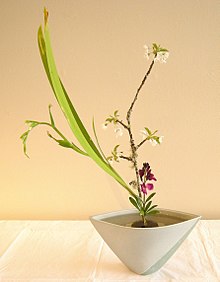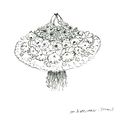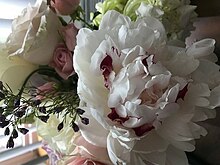
Ikebana is the Japanese art of flower arrangement. It is also known as kadō. The tradition dates back to Heian period (794–1185), when floral offerings were made at altars. Later, flower arrangements were instead used to adorn the tokonoma (alcove) of a traditional Japanese home.

Floristry is the production, commerce, and trade in flowers. It encompasses flower care and handling, floral design and arrangement, merchandising, production, display and flower delivery. Wholesale florists sell bulk flowers and related supplies to professionals in the trade. Retail florists offer fresh flowers and related products and services to consumers. The first flower shop in the United States opened prior to 1851.

Floriography is a means of cryptological communication through the use or arrangement of flowers. Meaning has been attributed to flowers for thousands of years, and some form of floriography has been practiced in traditional cultures throughout Europe, Asia, and Africa. Plants and flowers are used as symbols in the Hebrew Bible, particularly of love and lovers in the Song of Songs, as an emblem for the Israelite people, and for the coming Messiah.

A corsage is a small bouquet of flowers worn on a woman's dress or around her wrist for a formal occasion. They are typically given to her by her date. Today, corsages are most commonly seen at homecomings, proms, and similar formal events.

Korean gardens are a type of garden described as being natural, informal, simple and unforced, seeking to merge with the natural world. They have a history that goes back more than two thousand years, but are little known in the west. The oldest records date to the Three Kingdoms period when architecture and palace gardens showed a development noted in the Korean History of the Three Kingdoms.

A doily is an ornamental mat, typically made of paper or fabric, and variously used for protecting surfaces or binding flowers, in food service presentation, or as a clothing ornamentation, as well as a head covering for Jewish women and Christian women. It is characterized by openwork, which allows the surface of the underlying object to show through.
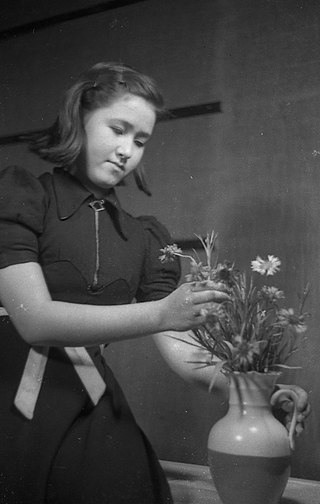
Floral design or flower arrangement is the art of using plant material and flowers to create an eye-catching and balanced composition or display. Evidence of refined floral design is found as far back as the culture of ancient Egypt. Floral designs, called arrangements, incorporate the five elements and seven principles of floral design.

Moribana is one of the expressions of Japanese flower arrangement Ikebana. The word Moribana means "full bloom flowers".
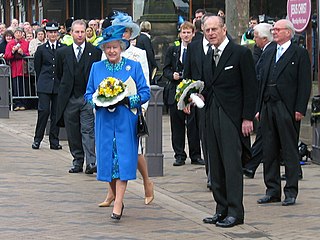
A nosegay, posy, or tussie-mussie is a small flower bouquet, typically given as a gift. They have existed in some form since at least medieval times, when they were carried or worn around the head or bodice. Doilies are traditionally used to bind the stems in these arrangements. Alternatively, "posy holders", available in a variety of shapes and materials, enable the wearing of these arrangements "at the waist, in the hair, or secured with a brooch".

Ikenobō (池坊) is the oldest and largest school of ikebana, the Japanese art of floral design.

Rikka is a form of ikebana.

The history of flower arrangement dates back to ancient Egyptian times.
In the United States and Canada, weddings follow traditions often based on religion, culture, and social norms. Most wedding traditions in the United States and Canada were assimilated from other, generally European, countries. Marriages in the U.S. and Canada are typically arranged by the participants and ceremonies may either be religious or civil. There is a tradition that the prospective bridegroom ask his future father-in-law for his blessing.
A flower girl is a young female who scatters flower petals down the aisle during a wedding procession.

Flower preservation has existed since early history, although deliberate flower preservation is a more recent phenomenon. In the Middle East, the bones of pre-historic man were discovered with delicate wild flowers probably as a tribute to a passing loved one. Evidence of deliberate use of specific flowers is indicated by the pollen grains that were present. Brightly colored and vivid flowers were also found in Egyptian tombs. These flowers were approximated to be 4,000 years old. In the sixteenth century medicinal nosegays began to give way to ornamental ones. Flowers essentially started to be used for decorative purposes such as jewels, fans and gloves. During the Elizabethan Age the once familiar ruff was replaced by soft lacy collars, and bosom flowers also became popular.
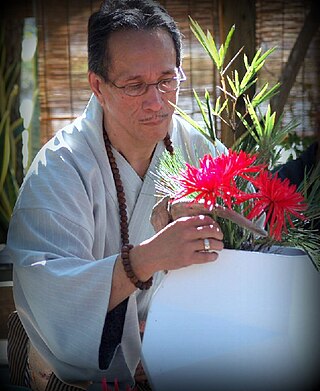
Banmi Shōfū-ryū (晩美生風流) is a school of Ikebana, an ancient Japanese art form that involves arranging flowers for spiritual purposes. Ikebana accompanied Buddhism's arrival in Japan in the 6th century and evolved from a Buddhist ritual. This ritual, which started in India, consisted of throwing “floral offerings” to the spirits of those who had passed. By the 10th century, containers were used for the floral offerings, slowly representing the development of Ikebana. Kado, which means “way of the flower,” is used in Ikebana practice and began to spread into more of an aesthetic than a spiritual representation during this time. By the 15th century, Ikebana embodied what it is known for today, an art form with a spiritual foundation. Ikebana is a way to connect with the flowers through active meditation, producing calmness and concentration for those who engage in this complex and expressional art. Ikebana has also been shown to have calming physiological effects on both creators and viewers of the art.

A vegetable bouquet is a collection of vegetables in a creative arrangement. Vegetable bouquets are often considered as an alternative to flower bouquets. Vegetable bouquets can be handheld or can be used for the interior decoration. They are often given as a gift for special occasions such as birthdays, anniversaries, or romantic dates. They are also occasionally used in weddings. Vegetable bouquets that contain fruit, flowers and other vegetation in addition to vegetables are commonly referred to as vegebouquets.

Nageirebana (抛入花), also known as simply nageire, is a style of ikebana. It is also known as Heika (瓶花).

Seika (生花) is a form of ikebana. Written with the same kanji characters, it is also pronounced and known as Shōka.

National symbols are the sacred attributes for Ukrainian people. In Ukrainian graphics there exist a number of symbols and images from national songs, legends. Such symbols and imagery are used in national customs and rituals. They are reproduced in embroidery on national costumes, ritual cloth—rushnyks, painted on crockery, in forged products, in carving, in bas-relief house decoration, in hearth painting, pottery, engraving and also in Ukrainian traditional Easter eggs—pysanky.

